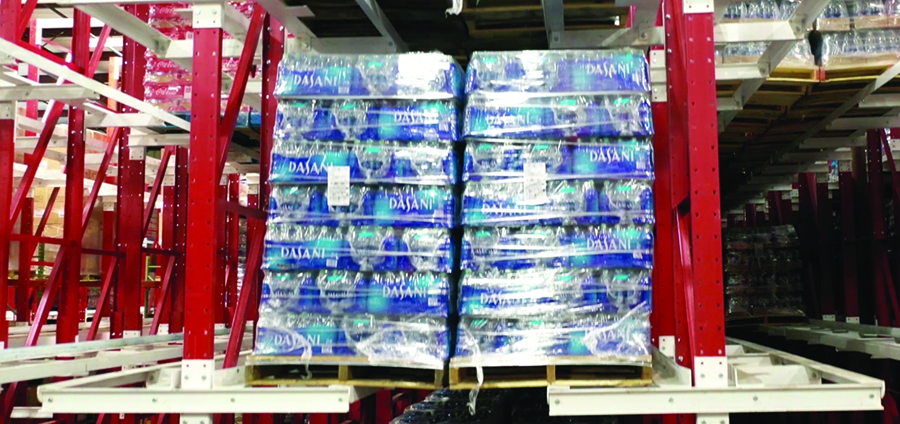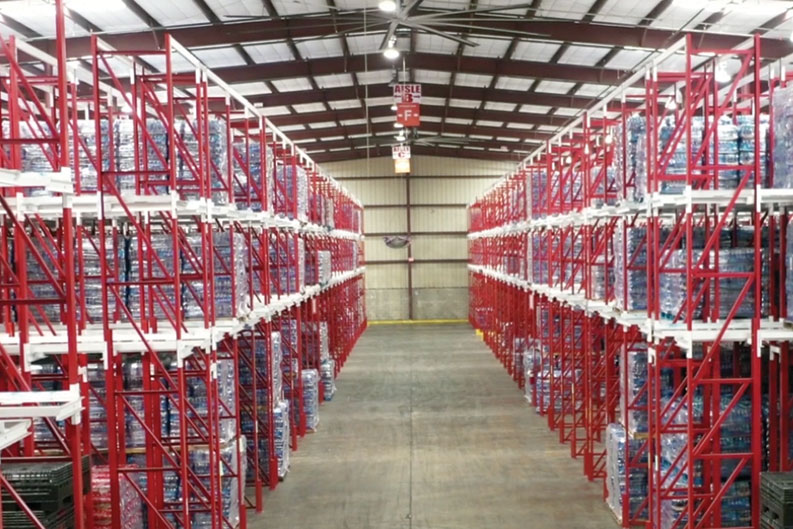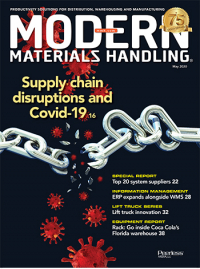Warehouse with a life-saving mission
In Jacksonville, Coca-Cola Florida had just opened an upgraded high-density overflow warehouse when it took on a mission never imagined during its design—supplying beverages for a pandemic. Preparedness and simplicity are key to its success under dire circumstances.
When the folks at Coca-Cola Beverages Florida bought a warehouse in Jacksonville last year, they knew what they wanted. They just didn’t know that they weren’t thinking big enough at the time. They know better now.
For three years, Coke had been leasing the 108,000-square-foot facility to store about a half million cases of sparkling drinks and water. The intent, explains Jason Reed, senior vice president of product supply network, was to convert the warehouse into an overflow facility for 1.5 million cases of product from a nearby bottling plant.
But there’s more here than just overflow. “When a hurricane hits, demand, especially for water, goes up exponentially. And, we have to be ready to meet the need,” says Reed. “But, hurricanes are one thing. We never anticipated a pandemic.”
More than just overflow
The company’s Jacksonville bottling plant is about a quarter mile away and doesn’t have sufficient on-site warehouse capacity to match production. That facility, by the way, annually produces 16 million cases of drinks from Coke and Diet Coke to Coke Energy and both Dasani and Aha water.
The back half of the new DC, affectionately known as H2, is filled with cases of water destined for distribution during those hurricanes. In fact, says Reed, the facility is designated an essential business as a hydration supplier by the Department of Homeland Security.
But it wasn’t until 60 days ago, however, that H2 started supplying food retailers and others as people stocked up to stay at home during the Covid-19 crisis.
“Daily shipments increased roughly 25% to about 200,000 cases a day with the pandemic,” says Reed. Those shipments, while dominated by cases of water, have included the full range of Coke products stored in the warehouse.
When Reed was interviewed for this story, Florida had just implemented its stay-at-home order. At that point, Reed expected those elevated levels would remain for another two or three weeks before beginning to normalize as people stopped stockpiling.
Coca-Cola Florida’s success here has not gone unnoticed. Reed says retailers have offered accolades for the drink supplier’s ability to keep their supply chain up and running. Not every other supplier was able to do the same, says Reed. “The inventory in that warehouse is a valuable asset especially in times of dire need,” adds Reed.
That win for Coke, he points out, is not just the result of high shipment velocity from H2. It was also made possible by high efficiency on the part of the company’s transportation and delivery supply chain.
“This facility is a strategic anchor point for product storage for the state of Florida. H2 also supports the company’s volume, growth and innovation strategies,” says Reed.
What follows is the story behind the warehouse that Coca-Cola Florida had no idea it was building for a pandemic.

Drive-in rack provides high-density storage of a range of Coke products.
Drive-in rack wins the day
During the first couple of years that the company used the facility, almost all cases were floor stacked. Only a small section of racking existed. To triple the capacity, a lot more rack was needed since the plan did not include expanding the facility’s 108,000-square-foot footprint.
The decision to use rack and lift trucks to manage inventory is not unique to Jacksonville, explains Reed. In fact, all of the company’s Florida warehouses use rack or floor storage. Together, they manage 100 million cases a year produced at the company’s four bottling facilities scattered around the state. Automation is not part of the mix, yet. More on that later.
The decision was made to go with drive-in racks throughout the facility, says Reed. This decision, too, was not unique to Jacksonville.
In fact, the company has used Twinlode drive-in rack at several facilities over the years. And, Twinlode’s national account manager Mike Williams has been deeply involved with many of those installs.
“Drive-in rack design is best suited to Coke’s high-density storage operations,” Williams explains. Alternatives include push-back and flow rack. However, both of those rack designs are not as well suited to the throughput and handling requirements of the facility, says Williams.
“We are most interested in the simplest, most basic rack at the lowest cost per pallet position for high-density storage of really heavy pallet loads of drinks,” says Reed. Drive-in rack, adds Williams, is one-third the cost per pallet position compared to automated solutions.
It’s not uncommon to maximize storage density in a limited footprint by going several storage levels high. However, the Jacksonville facility has a clear height of 32 feet, limiting racks to four levels. That was also the maximum vertical reach for the counterbalanced lift trucks already at the facility. So, all rack in the facility is four high.
Getting the layout right
When it comes to product flow, the warehouse has two schemes.
In the front half of the facility, there are roughly 1 million cases of a broad range of drinks, totaling about 150 SKUs. This product turns at a much faster pace than the rest of H2, turning roughly every 10 days.
The back half is dedicated to cases of water staged for natural disasters and is expected to sit there for six months or longer. That required a split design, explains Williams.
The front half has 5,700 pallet positions. The front third has two aisles, and there are three aisles in the back two thirds. An office area fills out what would have been a third aisle of storage up front. All aisles are 16 feet wide and racks are 11 bays deep.
The back half has 11,500 pallet positions. A single, 18-foot wide aisle splits the storage with 24 pallet positions deep on the right side and 22 pallet positions deep on the left. Seven SKUs are stored in this section.
Two pallet sizes, 36 x 36 inches and 40 x 48 inches, can be stored in the high-density rack. In fact, the design can accommodate both sizes at the same time.
How H2 operates
Operation of the facility is fairly straightforward: pallets in, pallets out. It runs two shifts, six days a week. In an average week, H2 moves in and out 100 to 130 truckloads of pallets or about 150,000 cases.
Coke gets double duty out of every lift truck run, moving two pallets at a time. A double-shifter attachment handles two pallets side by side.
Lift trucks drive into standard over-the-road transport trucks to pick up two pallets. Putaway is directed by Coke’s warehouse management system.
To store pallets, a truck simply drives into the designated storage lane as far forward as possible, dropping off the load at that location. The driver then backs the truck out of the lane to drive to the next assignment.
Product picking is basically the same process but in reverse in terms of load handling.
“The drive-in rack is really easy for the driver to maneuver a load. There is no complexity to the putaway or pickup operation because the rack is so simple,” says Reed.
Looking to the future
The first six months of H2’s operation in its new layout has certainly been eventful. But, already Reed and others are looking at what can be done to make it even more efficient.
They have noticed that a choke point is moving pallets in and out of over-the-road trucks at the docks. It simply ties up more time than desired to maneuver the loads with conventional lift trucks.
Reed says they’re now looking at automation at the docks. A leading possibility is automatic guided vehicles (AGVs) that would load and unload over-the-road trucks. On the delivery side, they would position pallet loads for pickup by the counterbalanced trucks. On the shipment side, they would pick up loads left by those trucks. The idea is to free up trucks for putaway and picking of loads.
If AGVs were added to the operation, that would be a first for Coca-Cola Florida. And in that case, it would be entirely in keeping with other innovative firsts at H2.

Article Topics
Rack News & Resources
Steele Solutions showcases advanced structural steel platforms and materials handling chutes Frazier shows Pallet Spacing System and Method Steel King Industries announces strategic collaboration with Automha Americas Nucor discusses future rack project Toyota Material Handling receives Manufacturing Excellence award for Community Impact Conventional warehousing update 60 Seconds With Kevin Curry, industry veteran More RackLatest in Materials Handling
Registration open for Pack Expo International 2024 Walmart chooses Swisslog AS/RS and software for third milk processing facility NetLogistik partners with Vuzix subsidiary Moviynt to offer mobility solutions for warehouses Materials Handling Robotics: The new world of heterogeneous robotic integration BSLBATT is looking for new distributors and resellers worldwide Lucas Watson appointed CSO for Körber’s Parcel Logistics business in North America Hyster recognizes Dealers of Distinction for 2023 More Materials HandlingSubscribe to Materials Handling Magazine

Find out what the world's most innovative companies are doing to improve productivity in their plants and distribution centers.
Start your FREE subscription today.
April 2024 Modern Materials Handling

Latest Resources












